Essentials on the what to pack list:
No 1: Waterproofs
First up on Julia’s walking holiday packing list are waterproofs. “Wherever you’re going, whatever your destination, pack your waterproofs,”
If you’re an active family with kids aged 12 and up, yearning for an unforgettable adventure, look no further than the Highlands of Scotland. Scot Mountain Holidays offers a unique 2-day, 3-night experience designed to immerse you in the stunning landscapes and rich history of the Cairngorms. Here’s a glimpse into what awaits your family on this off-the-beaten-track journey.
Your adventure begins with a warm welcome at Fraoch Lodge. Arrive later in the day and join us for a delicious dinner made from local produce, much of it sourced from our own garden (except in the depths of winter). Over dinner, we’ll chat about your travels, families, and plans for the days ahead. Andy, our experienced guide, will check the weather and suggest a route for the following day’s hike. He’ll also ensure you have the right gear, as Scottish mountain hikes offer few opportunities for last-minute changes or resupplies.
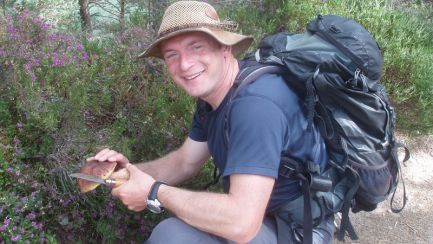
Wake up to a hearty breakfast of your choice, prepare your packed lunch from an array of fresh options, and get ready for a day of exploration. Andy, who has been guiding in the Cairngorms for about 25 years, will lead you on a hike designed to familiarize you with the area. His deep knowledge of the landscape and its history will make this an enriching experience. You’ll learn about the unique flora and fauna, geology, and environmental conservation efforts in the region.
After your hike, return to the lodge where tea, cake, and a cozy fire (weather permitting) await you. Before dinner, we’ll review the weather and plan your route for the next day. This time, you’ll be on your own but fully equipped with a map, route description, and any necessary transportation arranged by us.
Start your day with another delicious breakfast and prepare for your self-guided hike. Armed with the knowledge and experience gained from your day with Andy, you’ll set out on a personalized route designed to match your ambitions and the prevailing weather conditions. Whether it’s a linear trail offering new vistas or a loop showcasing the diverse landscapes of the Cairngorms, you’re in for an adventure.
One of the highlights of hiking in this region is the chance to encounter wildlife. The Cairngorms are home to capercaillies, crested tits, reindeer, pine martens, wild cats, and the rare red squirrel. You never know what you might see on your journey.
At the end of your hike, we’ll pick you up and bring you back to the lodge for more tea, cake, and relaxation by the fire. This simple formula of eat, sleep, hike underlies all our trips, ensuring you’re well-fed and rested for each day’s adventure.
On your final morning, enjoy a leisurely breakfast and soak in the last moments of your Highland retreat. Despite the physical exertion, you’ll leave feeling mentally refreshed and ready to return home with memories of an incredible family adventure.
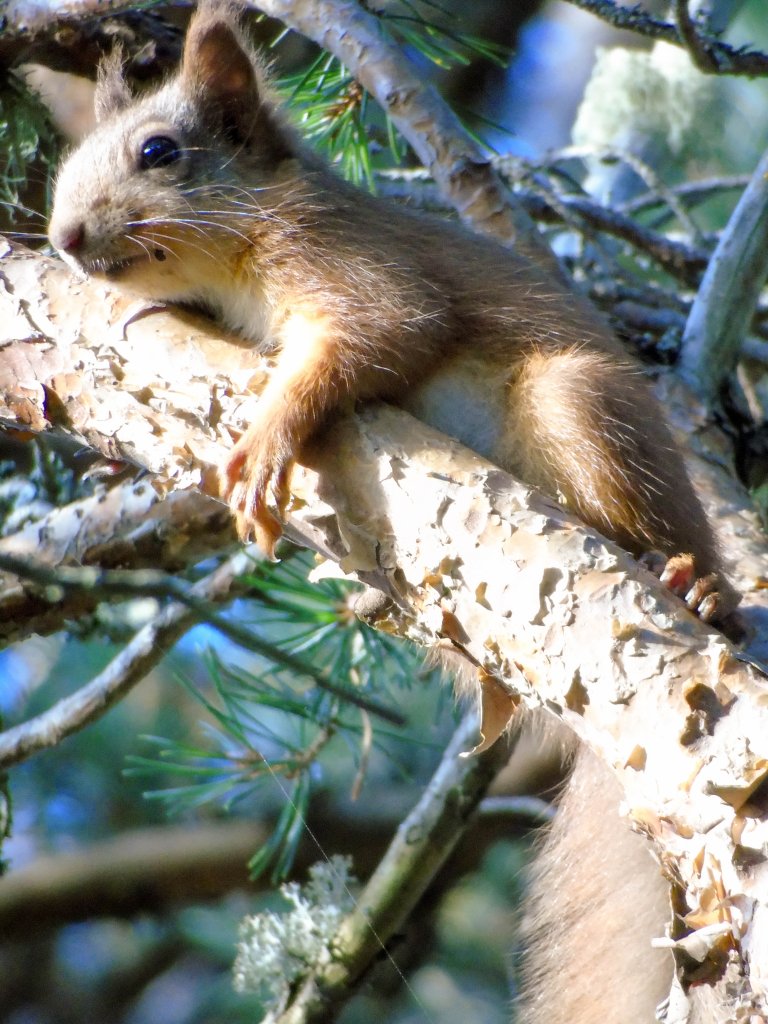
Only 120,000 red squirrels are left in Scotland. Less than half the number of grey squirrels.
Our “Get Off the Beaten Track” package is designed for families looking to explore and understand the Highlands through the eyes of an experienced guide. The base package includes:
For those looking to extend their stay, we offer optional packages including:
Ready to plan your Highland adventure? Email us for help in crafting the perfect vacation, hitting all the Highland hotspots and uncovering off-the-beaten-track surprises. For inspiration, check out our Pinterest board and Flickr account.
Join us at Scot Mountain Holidays for an adventure that will bring your family closer to nature and each other. The Highlands of Scotland are waiting for you!
Email us if you think we can help plan your vacation in Scotland – we can hit all the Highland hotspots and include some off the beaten track surprises you might not know about.
What does ‘off the beaten track mean to you’? Depending on how adventurous you are, the phrase can mean different things to different people. It can be scary to choose the path less travelled by, but the benefits from getting off the beaten track in Scotland are exhilarating.
But, this certainly doesn’t mean you need to skip all the top sites like Loch Ness. For some, getting out of cities is rural enough and therefore Loch Ness is a great choice. But for those feeling adventurous and wanting to get a little more remote, we can help you there.
Wanting to find a little peace and quiet is the most natural thing in the world whether you’re most at home surrounded by nature, a city dweller or somewhere in between. And arguably, there is no better place than the Highlands of Scotland. Known for its epic beauty, contrasting scenery and out of this world views, you’ll soon find yourself where the air and water are fresher and the most prominent noises keeping you company is nature at its finest.
The Cairngorm National Park is the ideal base for you to experience and explore the remoteness the Highlands can offer. Depending how far off the beaten track you want to get you’ll find an array of options suited for all fitness levels and ages. Offering options to be guided, or self exploration if you prefer, Scot Mountain Holidays has it all.
We understand that only you know what getting off the beaten track means. But, Scot Mountain Holiday trips, by definition are all off the beaten track. It’s unlikely you’ll see crowds of people during any typical day with us. Choosing one of our trips is a great way to decide if the more unusual spots and a more active vacation is the way forward for you.
Whether you’re after hiking, mountain biking, walking or countryside relaxation, you’ll find it here. We can help organise a tailor-made trip for you, friends and family. Or, you can join one of our scheduled trips where you’ll meet like-minded people and gain friends for life. The choice is yours.
Scotland is an amazing destination renowned for many things: castles, golf, kilts, haggis and it’s amazing scenery. Scotland is also promoted as an adventure destination. However, there are thousands of people who visit Scotland every year but have no idea of the opportunities they can experience. Your experience is greatly enhanced if you invest a wee bit in expert guidance. Many people list our scenery as one of the motivating factors for a visit to Scotland. It also ranks highly as one of the reasons to go hiking.
Choosing a holiday destination is not always easy. There are a lot of considerations which come in to play. How much time do you have available? How much money do you have available? Do you have a short list to choose from? What images are influencing you? And these days, of course, you have your friends images and reviews to peruse via social media. If you’re a keen hiker, you probably already know, that Scotland has amazing scenery. Maybe you’re putting Scotland on your short list. In our experience running accommodation and adventure holidays in Scotland, it’s still got untapped potential and a lot of advantages as an adventure destination which most people don’t know about.
Waiting for the cloud to clear to reveal the spectacular view which can’t be seen from the road.
Photo credit: Scot Mountain Holidays
Photo description: A guided hiking vacation in the Cairngorms, Scotland – off the beaten track thanks to our excellent, world-beating access legislation.
Everyone has a right of responsible access in Scotland due to The Outdoor Access. You are legally allowed to walk/bike/canoe anywhere they wish. You do need to avoid the immediate grounds of a building. So you don’t have the right to walk across someone’s manicured garden. You do have the right to roam the hills at will without sticking to what few paths there are.
Do be careful when out on the high ground though because there is not a system of well-maintained way marked paths across the hills, unlike other European countries. In fact, if you have not been out hiking in Scotland before it would be advisable to book a local guide for the first time you go out. You will have a more in-depth appreciation for the countryside you’re walking through with your guide.
The guide would have extensive knowledge of:
which you as a visitor would never be able to glean during your short visit to the area without his/her presence.
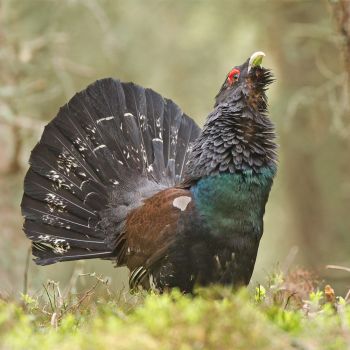
Photo credit: Jamie MacArthur (www.ornithography.com)
Photo description: A Capercaillie in the Cairngorms
Scotland has celebrated the Year of Natural (2013) and the Year of Adventure (2012). The Golden Eagle was voted Scotland’s most iconic species. The attraction of the wildlife is a growing sector of tourism in Scotland, particularly to the Highlands and Islands. You could expect to see red squirrels, red deer, reindeer, roe deer, eagles, otters and a multitude of other animals throughout the Highlands. Most of these iconic animals are frequently found in the Cairngorms. The Cairngorms feature heavily in all the BBC Spring, Autumn and Winter Watch programmes. However, you don’t need to worry about bear or wolf attacks. There are no large animal predators in the wild. Camping is a relatively safe experience; the main concern being a biting fly known as the midge (which will not trouble you on a windy day and is only around in the main summer months).
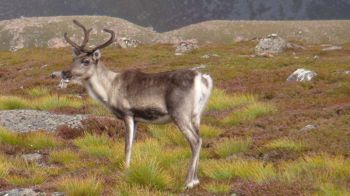
Photo credit: Scot Mountain Holidays
Photo description: Part of the Cairngorm Reindeer Herd which roam free in the hills during the summer months.
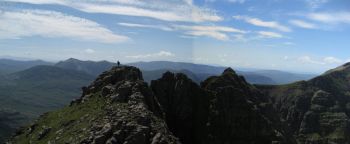
Photo credit: David Webster
Photo description: Ridge walking on Liathach, Torridon, Highlands of Scotland with Scot Mountain Holidays
Scotland has ancient mountain scenery full of mystique and history, which draws thousands of tourists every year. Most visitors only experience the views from the road. There are plenty of views to be seen from the roadside, but the best of the landscape can only be experienced by immersing yourself. Exploring the Highlands without a car has its trials but hiking, canoeing, adventure biking etc here in the Highlands is the way to go.
The beauty of Scotland speaks for itself in many images and has formed inspiration for movies and art worldwide:
There are several long distance paths which are waymarked across Scotland, but the high hills are not waymarked. There are paths which crisscross the high mountains but a knowledge of map reading and compass work are necessary to deal with the changeable weather conditions and wild scenery.
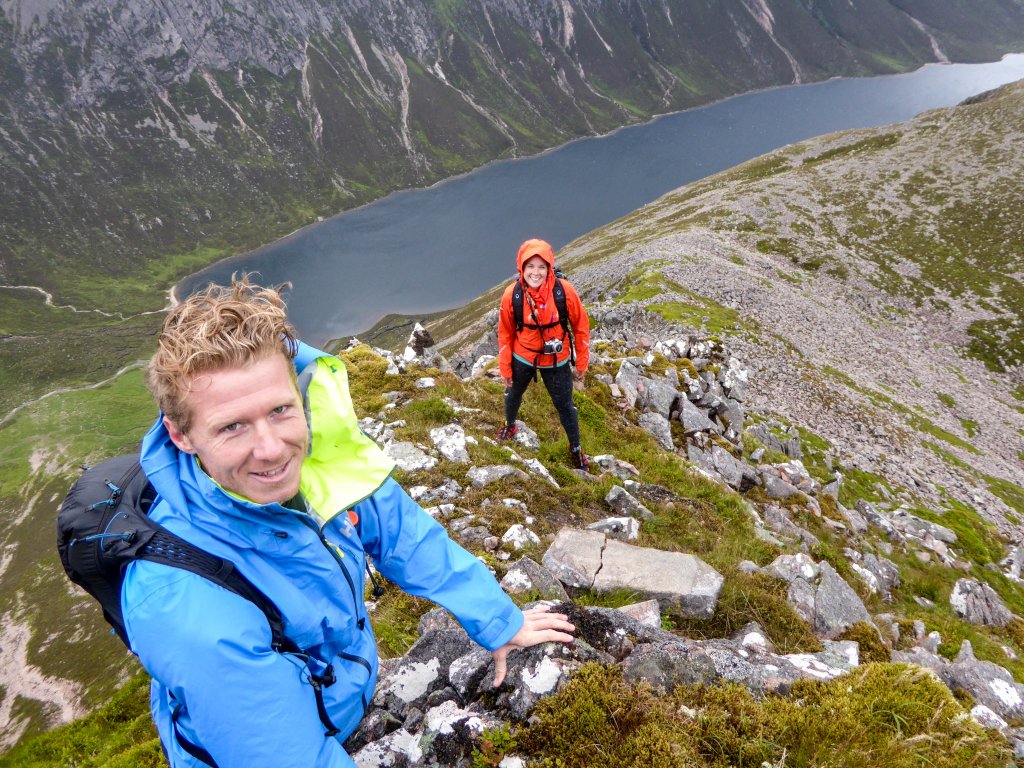
Happy snaps mid climb
Photo description: Viewpoint obove Loch Aan in the Cairngorms showing the cliffs by shelter stone. Some of the stunning features of the Cairngorms which can’t be seen from the road.
Scotland’s highest peak is Ben Nevis at 1,344m. To many Europeans this seems merely a bump, but when you consider that the route up the mountain starts at sea level, it becomes a decent mountain day. Most people take about 8 hours to complete the route up and down Ben Nevis, even by the regular “tourist” route; but for all that it is not an 8000m peak it should still not be under-estimated.
The changeable weather conditions, our maritime climate, in the UK make an ascent of any of the hills challenging, except in the most stable of weather conditions. People do die in our mountains every year. You don’t need to worry about altitude sickness or having to carry oxygen to summit the mountain and most summits can be reached without any need for ropes. All risks in the mountains can be limited by employing a guide with the relevant training and experience.
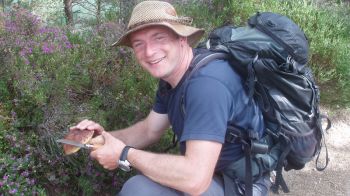
There are international flights to Scotland through Edinburgh and Glasgow with onward flights or good public connections through bus and train onwards to the Highlands. However, to make the most of your time in the Highlands your best transport option is still either to hire a car or to book a suitable tour with a guiding company which will take in the routes at the top of your list or allow them to pick to routes best suited to your ambitions, taking account of the prevailing weather and terrain conditions.
You can reach most of the hills in Scotland on a day walk, within the capabilities of most hikers. There are more extensive routes – which take several days to complete, but you can reach the summit of most individual peaks in a day.
If you do choose to undertake any of the long distance routes you will find that with the exception of the West Highland Way and possibly the Great Glen Way, you are unlikely to see many other people during your walk. So far, Scotland is accessible without being crowded.
The following companies are expert at arranging walking tours and hiking holidays of various kinds:
Hiking is the ideal way to explore the Scottish Highlands
Visit Scotland’s walking information
WalkHighlands: A comprehensive resource for any independent hikers planning to visit Scotland:
Check out the Lairig Ghru mention in the top list of walks in Scotland
Ramblers info about walking in Scotland
12 Trail rules you should know
8 of the best long distance hikes in Scotland
How exciting! The approach of the school Easter holidays is always an exciting time here in the Highlands of Scotland, especially in Boat of Garten, as it signifies the start of so many more opportunities to get out and about. Winter can be a bit of a sleepy time, when if you don’t ski, there are far fewer places to go and things to do than during the summer. Many of the castles and other visitor attractions either close or are on such reduced opening hours, you wonder why they bother at all. But once we’re over half way through March, we can look forward to being spoilt for choice

The ospreys should be returning to Boat of Garten in April. The RSPB are poised to open up the visitor centre over the Easter holidays and are closely monitoring the birds on their migration back to Scotland. Unfortunately sometimes the chicks get lost over in Africa, but hopefully our current pair will make it back safely. It’s been a bit of a soap opera down at Loch Garten in recent seasons so who knows what’s in store this year.
The centre itself has been through quite a revamp though so we now have webcams to see the white tailed (sea) eagle’s nest and a goshawk nest as well as the Ospreys.
Your Natural Adventure in the Cairngorms
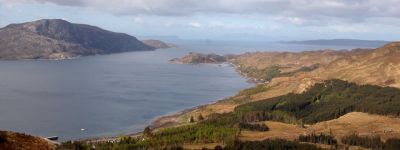
Photo Caption: Wild and remote scenery of Knoydart on a visit in May – Wild Knoydart guided walking holiday
If we think about hiking in Spring, the long daylight hours definitely make it more pleasurable – if challenging to get the kids to sleep when camping. At the beginning of March, we already have 10.5 hours of daylight here in the Cairngorms but by the end of March it’s already increased rapidly and we’re up to 13 hours daylight. For example, March 19th 2015 sunrise is around 6.20am and sunset about 6.25pm. Early starts no longer essential to make the most of the daylight.
Scottish sunrises and sunsets – images from Scot Mountain Holidays
Sunrise and sunset times in the Cairngorms
Don’t kid yourself – it’s hard to keep fit in winter. Even if it’s not snowing, the shorter days and cooler temperatures just bring to mind more images of hibernating than getting outside and hiking or biking.
Of course, there are those (in a large minority) who love winter for the snow, for the skiing etc; but for the rest of us it takes a cattleprod to get out to the gym … but then something magical happens by the middle or February as the days start to lengthen here in the Highlands and all of a sudden it’s not so hard to get up and out. There is certainly a reason why we have the phrase: “The Joys of Spring”. Now we can say goodbye to the inside of a sweaty gym and take the bike out of the shed, dust off the backpack and take the running shoes out in the woods and along the trails.
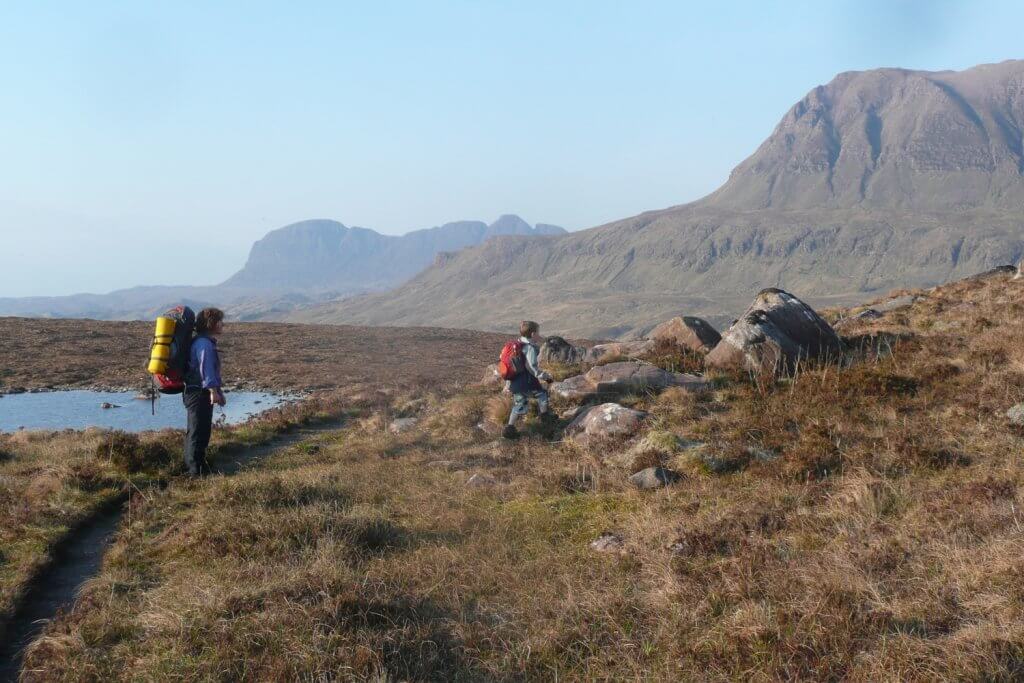
Hiking in to a secret wild camping spot in Assynt
Photo caption: Spring also means that it’s a time the kids can get back outside. You no longer need to wrap them up like Mummies. This photo was taken on a backpack to a wild camp in Assynt in May. If you’d like details of this trip, we can arrange this for small groups and family groups under Andy’s guidance.
In winter, we spend a lot of time instructing about the dangers involved in going out on the snow and ice. Andy runs multiple courses showing clients how to use ice axe and crampons and how to assess the risk of avalanches. All these are things which put the multitude of hikers off. Most people perceive the Highlands as being far too dangerous in winter. You’d almost be taking your life in your own hands to even consider it. Of course, reality is nothing like that and for the number of people who do go out in the hills. The number who have accidents or need to call on mountain rescue is a minute proportion. Accidents are always reported in the media which exaggerates the frequency with which they occur.
Nevertheless, Spring means that these worries can retreat once more and the hiking boots can be dusted off and the maps taken down once more to plan for some high level hikes across the hills. There’s a reason why events such as the TGO Challenge take place in the Spring.
Do bear in mind though – that winter is never far away in Spring here in the mountains and due to our latitude, snow can return with unexpected force in April and May.
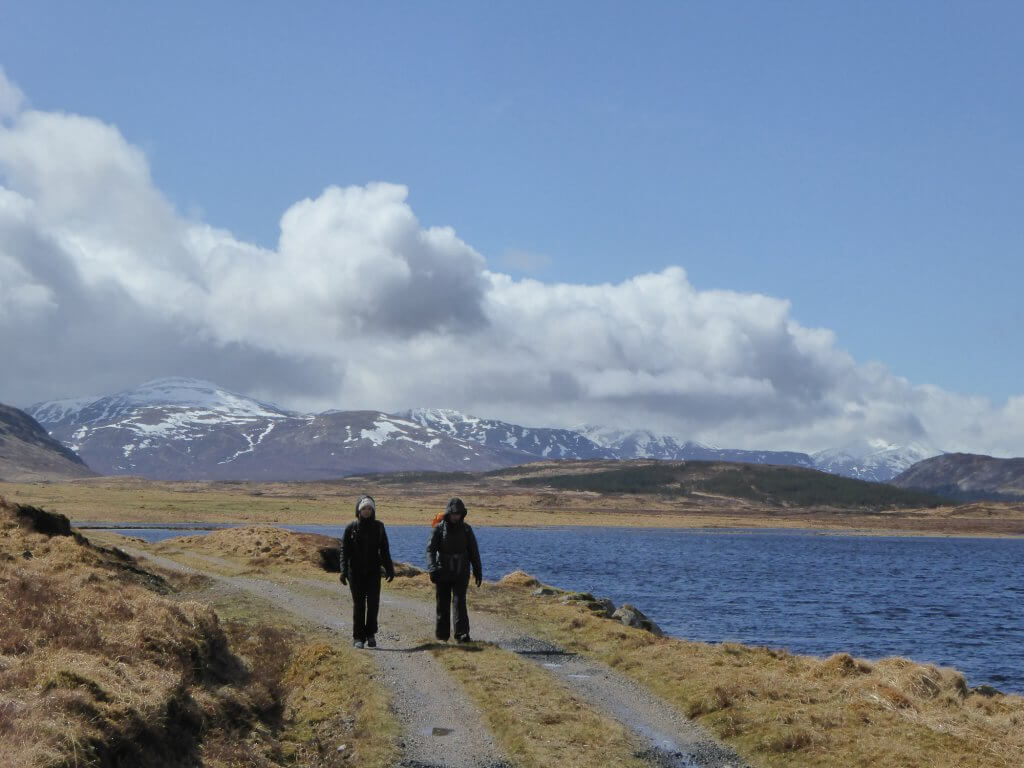
Perfect spring weather for hiking
Hiking in Spring means that you can enjoy long blue sky days, without the ever-present midge. To be honest, in the Cairngorms the midge question is not as great a threat as on the west coast. Despite the relative proximity of the west coast (in Australian or American terms) the weather is very different. In the Cairngorms, the weather is drier and the winters on average colder. Cold winters greatly reduce the presence of midges in the summer.
You can tell our local climatic zone is drier more often than the west coat by the colour of our hills. The hills in the Cairngorms in summer are purple as the bell heather flowers. Bell heather likes dry conditions to flourish. The wetter west coast hills are generally green and grass covered.
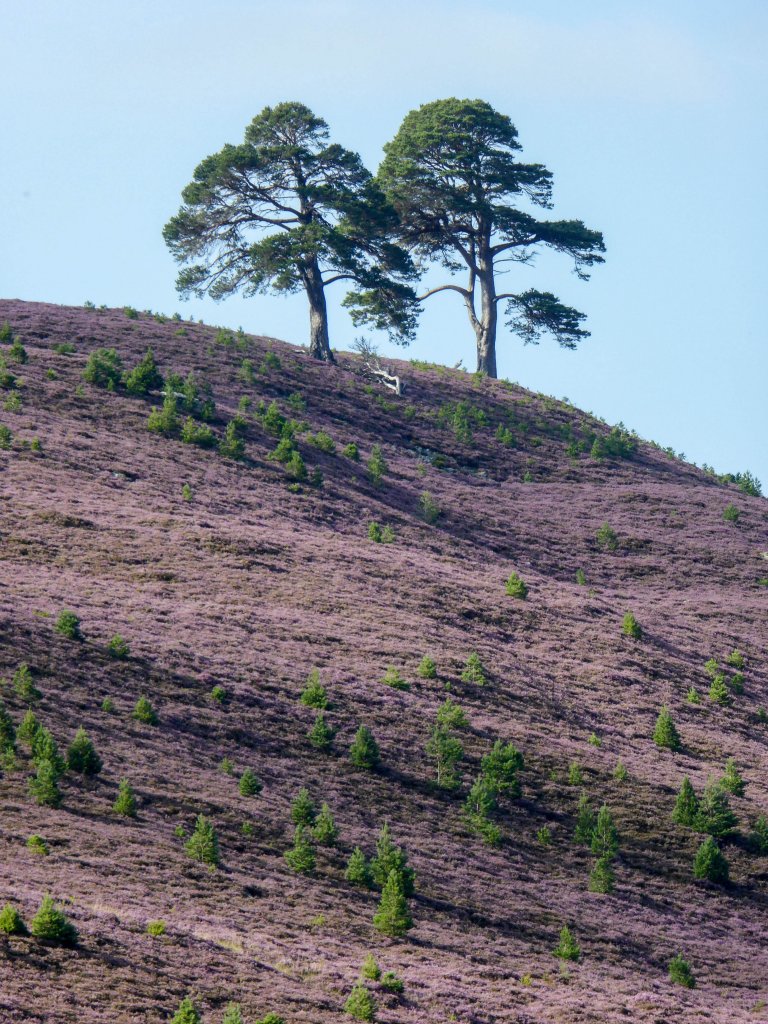
The trouble with planning a hiking vacation in Scotland is that you are almost spoiled for choice. There’s no way you will be able to fit everything in to one vacation.
The scenery on Skye and around the west coast of Scotland is remarkable from the road. It has inspired movies such as “Brave”. The draw is understandable but the disadvantage is that for Scotland it can be “touristy”. It will be unusually busy with other visitors. If you’re looking for a quiet experience of Skye when you have a chance to enjoy the scenery without the crowds, you’ll need to consider taking the time to explore there out of the main tourist season. April, May and September are the best times to head over there. You have a high chance of good weather and a low to non-existent chance of encountering the dreaded midges.
In recent years, particularly since the Land Reform Act (2003), there has been public money available to develop paths across Scotland. This has resulted in a proliferation of way marked long distance routes. The Land Reform Act (2003) formalised the right of access to all land in Scotland, whether privately or publicly owned. Access rights are for outdoor recreation, for crossing land and water, and for some educational and commercial purposes. Exercising access rights, and managing access land, must be done responsibly.
The most well-known of the long distance routes is the the West Highland Way, but there are many others like the Speyside Way (the one to do if you’re in to whisky). Another recently mapped route which is less formally organised is the Cape Wrath Trail. This trail is described by Cameron McNeish as: “It’s the sort of long distance route that most keen walkers dream of. A long tough trek through some of the most majestic, remote and stunningly beautiful landscape you could dare imagine.” You can research more details here: http://www.capewrathtrail.co.uk/foreward.htm There is also a recently published map by Harvey maps covering the area involved.
A full list of long distance paths across Scotland is available here:http://walkhighlands.co.uk/long-distance-routes.shtml They range in length from 338km to 38km. Some can be linked together to make a longer route.
The disadvantage, depending on your point of view, of most long distance paths in Scotland is though they go through mountainous areas most if not all of these routes do not go up the mountains so if you stick to the waymarked route you’ll only be admiring the peaks from afar.
Photo Caption: Long distance path walking in Scotland
There has been quite a lot of investment in path construction and signage in Scotland since the development of the Outdoor Access Code in 2002. There are opportunities virtually everywhere to get out of the car and explore a wee bit to a viewpoint or through spectacular woodlands or around a loch etc. The difficulty is in knowing which option to choose.
WalkHighlands can help with this in that all the walks they list are graded and have an estimated length in distance and time. However, possibly the best way of choosing is to ask your hosts at your accommodation for their recommendation of the best walk to choose and if you have a wee bit more time available take advantage of a guided walk as you will gain so much more insight into the area from the guide’s knowledge. There are ranger guided walks in most areas, particularly in the National Parks like the Cairngorms and the Trossachs which will reduce the cost. Some of these walks are even free. Boat of Garten has it’s own ranger service offering guided walks around the woods behind the village. The RSPB also offer guided walks on the Abernethy reserve.
The advantage of booking a walk with a guide is that you’ll be able to get off the beaten track with confidence. You might even be able to do a longer walk or go higher than you would be confident doing on your own.
A guide will also have extensive knowledge of the local folklore, the environment, the flora and fauna as well as the terrain through which you are hiking. There really is nothing better for bringing the area alive to you. As a student or cash strapped tourist you may consider the cost relatively high. However when you look at the cost of eating in a restaurant or your accommodation for the night, you’ll realise that on an hourly rate your guide is not charging a lot of money. A qualified mountain leader will have invested years of training into his qualification not to mention the cost of the training course itself.
A qualified mountain leader (or accompagnateur) will charge from £150 – £200 for a day out. This fee will be split across the clients in the group. The larger your group of family the less the cost per individual. The rewards of going out with a guide for the day are however beyond price as you will learn so much more about the area which you won’t find in the guidebooks.

Most organised hiking tours will explore only one area in depth. While this approach is not for everyone (many people visit a country with a tick list of sights they want to visit – which are inevitably the same spots 90% of visitors also want to see, resulting in overcrowding), if you go on an organised vacation you are often more likely to have a more genuine and authentic experience of the country you are visiting.
It is worth checking that the company you book with has a philosophy which appeals to you. Also that the structure of the trip suits your priorities. For example, if you are thinking of booking with Scot Mountain Holidays but it is important to you to have 5 star hotel style accommodation, rather than a home away from home, you will probably look elsewhere for your trip. The philosophy behind our vacations is that our guests stay within our home. They immerse themselves in the atmosphere and feel comfortable discussing all aspects of life in Scotland.
Of course, if you have enough time you could consider a shorter, organised trip as part of your vacation and tour the rest of the country by car/bus.
Think about access – a major consideration as part of the planning. Some areas of the Highlands are more difficult to reach than others. For our organised vacations we have tried to make it as easy as possible for our guest to access them. We offer pick ups from Aviemore station and Inverness airport. In the Cairngorms, we are lucky enough to be near the major route north from Edinburgh – the A9, which makes it very efficient to get here.
It may look like it isn’t far to reach some areas of the Highlands but travelling on narrow, sometimes single track roads, will take longer than anticipated.
When planning your trip bear in mind that reaching some areas by public transport can be time-consuming. Many of the routes used have to go around rather than through the mountains.
Julia Bradbury recently published her tips on what to pack for walking holidays in the Express. We thought we’d compare our packing lists. Let’s have a look at Julia’s top picks.
This is not by any means intended to be a comprehensive kit list. Don’t use it to pack for your next walking break, but we just wanted to highlight one or two things which have been essential on our own trips plus have a quick look at items we’d consider non-essential/luxury items as we think it’s essential to have something in your pack which gives you some additional pleasure at the end of the day.
First up on Julia’s walking holiday packing list are waterproofs. “Wherever you’re going, whatever your destination, pack your waterproofs,”
It seems obvious to an experienced walker that you should always pack your waterproofs, particularly if you are an experienced walker in the UK. You expect the weather to change. However, if most of your walking has been done in a continental climate, you might be forgiven for expecting the weather to be consistent. On our recent holiday in the Sierra Nevada (Spain), we did meet some hikers (even on the highest peak, Mulhacen, at over 3000m) who set out without waterproofs.
Lack of suitable clothing could cause you to have to turn back from your objective.
Be a scout when it comes to a hiking vacation and “be prepared”.

Julia also emphasises the importance of good walking boots – and you might want to consider investing in more than one pair.
“Make sure you’ve got the right kind of boots for the terrain you’re going to be walking through,”
“If you’re going for a boot that will suit all walks then an ankle boot is vital,” she said.
It might seem obvious to talk about boots for a walking trip, but not everyone thinks to pack walking boots. There are many who think that trainers will do. There are also extensive discussions and debates online in various walking/hiking forums as to the benefits and disadvantages of boots versus walking shoes. Those who have opinions either way are quite vociferous about the benefits on their side of the argument.
The most important thing is that your feet are comfortable.
Uncomfortable feet is the worst experience you could have if you’re committed to a hiking vacation. Feet can be uncomfortable in different ways but in our experience along with boots an essential item to pack is foot cream.
Another option is approach shoes which are becoming more popular. These are good for rough track terrain but not for steep inclines.
She added: “It’s good to have them in your backpack if you get your boots wet or you cross a river or your feet get wet for whatever reason.”
A second pair of footwear is in our opinion essential to the comfort of your feet. The last thing you want to do after a day out hiking in your main boots is to put them back on to go out in the evening
You must look after your feet as they are bearing the burden all day and to keep going you need to pamper them.
WHERE WE START TO DISAGREE
A more surprising item Julia likes to take is a tinted lip balm. “It gives you sun protection and a splash of colour on the lips as well.”
are also a must for a walking holiday, said Julia.
The walking enthusiast also advises taking a single strap rucksack, and weighing scales.
We’d have to agree with Julia’s top 2 picks. It seems really obvious to pack your boots and waterproofs if you’re heading off for a walking holiday (particularly if your destination is Scotland) but believe me sometimes people leave out the water/windproofs if they think they’re heading off to a warm destination, but if you’re going mountain walking anywhere you should always be prepared for the weather to turn.
On our recent trip to Spain there were other walkers who were caught out by the weather turning on Mulhacen. We all walked up in glorious sunshine, but woke up to drizzle. The higher up the mountain we went, the windier and colder it became. Those without waterproofs really suffered in the wind.
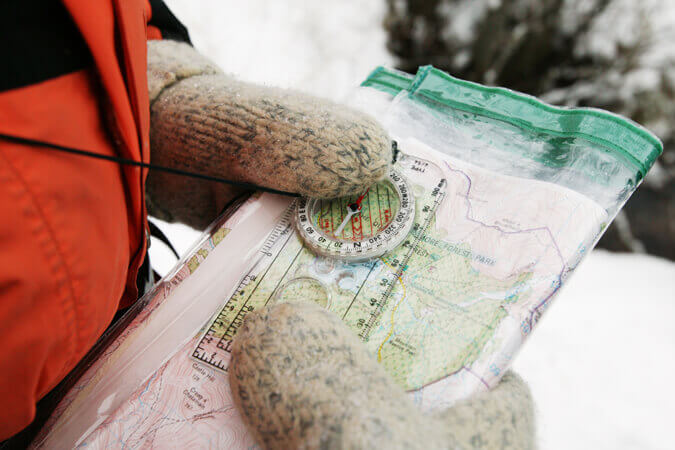
Dachstein mitts don’t necessarily mean that you won’t be able to use a compass or to navigate, as shown by our director Andy Bateman
For the other 3 items – are they really necessary? Are there other more important things you should make sure you have first?
Our top tips to you personally would be:
bring a map and if you have one a GPS &/or compass
Even on a guided trip it is useful to have your own map. These days you can quite easily get digital mapping on your phone. Personally we don’t like to rely on this as we don’t have the most up-to-date phones and the screen size can be really irritating. It is useful to be able to enlarge portions of the map though, especially as your eyes start to find the small print a bit more of a strain. However, if you’re going to rely on digital images, make sure you have an extra power pack for your phone. Personally this would rank higher up on our own list than flipflops or lip balm.
Because we can’t go on holiday in the main summer season (a dream for the future maybe), and therefore we are almost always away in October, we always pack gloves and hat. If you’re travelling in the main part of the summer season we’d recommend always packing a sunhat and sunscreen (even in Scotland) but not necessarily a midge net. Check our blog on how to have a midge free vacation
Be sure to have at least one item for yourself which you would consider a luxury (a bit like Desert Island Discs).
Our luxury items include:
a book/kindle
a knitting project
a teddy (perhaps only a consideration for the youngest member of your group)
chocolate
your favourite hiking snack which you buy at home
tea (for the British audience) or your favourite coffee
But don’t forget to leave a wee bit of space (if you can) for souvenirs!
What would your luxury item be?
We are frequently asked what to pack for a day hike in the Highlands, usually by our guests preparing for their guided walking tour with us. People often ponder on whether they should pack shorts, a sun hat, sunscreen. What gloves to bring etc – the list goes on.
Bear in mind, that if you are planning to head out on your own or at least without a guide, then you will also need to pack the following gear and be familiar with how to use it.
map & compass: you will need a good quality, local, walking map such as Harveys or Ordnance Survey (we stock the 1:50,000 OS map for our area). Do not rely on your mobile phone mapping.
You should also always pack some food (even small snacks) and some water. It is possible to refill your water bottle along the route, but take care if you are following a low level popular path. If there is a lot of livestock in the area, it would be best not to refill your bottle unless you have a water purifier with you.
Always tempting if you happen to strike the good weather to whip out the shorts to go for a hike. It is however worth bearing in mind that Scotland is not without its pests. There are ticks in Scotland which hang on the undergrowth, particularly at low levels waiting for someone or something to come past. Ticks are often carried by deer who rub them off on the vegetation. The ticks wait there for the next host to continue their life cycle. They can wait for years.
If you do pick up a tick it is not the end of the world. There is Lymes Disease in the UK which can be treated with antibiotics – but early removal of the tick is key to the prevention of the disease. We have tick removers here at Fraoch Lodge. Make sure you check yourself over at the end of the day. However, you can minimise the risk of picking up a tick by wearing long trousers and gaiters over the top of your boots. Generally speaking dog walkers and golfers are often at more risk than hikers of returning with ticks.
Unless you’re going to be battling through particularly overgrown parts of the countryside, the length of your sleeves is not too vital and the rate at which you get cold will determine whether you think long or short sleeves suitable for the day.
There are not many well graded, smooth paths in the Scottish hills. Most tracks are relatively rough with loose stones and rocks. It is usually sensible to use over the ankle walking boots to protect your ankles from turning and also to keep your feet as dry as possible. Leather boots, though heavier, should provide the best protection and will be generally more waterproof than gortex lined fabric boots.
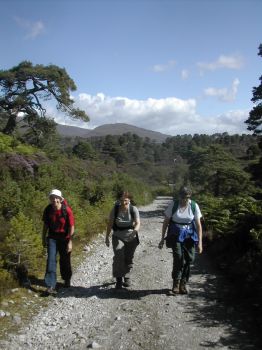
Waterproof shell jackets are by far the most popular. Most shops stock a wide range of jackets designed with gortex fabric. Andy himself prefers to wear Paramo clothing or Cioch direct waterproofs. Both these companies use the same material. Cioch Direct specialise in made to measure clothing. The advantage that the Nikwax analogue material has over gortex is that it is designed to be reproofed after washing so is likely to last you longer. The jackets can also be returned for repairs at little or no cost. The disadvantage is that the material is heavier and can prove to be too warm in the height of the summer – though at an average year round temperature of 0oC, the Paramo jackets are usually suitable for the Cairngorm plateau.
Always useful to include a warm hat and gloves at the bottom of your pack as it can be cool on the hill tops even in August.
The most sensible attitude to your clothing for hiking is to make sure you have several light layers which will provide maximum flexibility rather than one or 2 choices. Make sure that your layers are not cotton options as you could cool off very rapidly, should your cotton layer become damp whereas synthetic or wool layers will either dry more rapidly or stop you from cooling down too much.
The most useful size of packpack to bring with you is a 35 litre pack. This will be large enough to take all excess clothing, camera, packed lunch etc. Smaller than this may mean that you have to limit what you take on the hill, particularly in winter.
Wandering into the Cairngorms
Please don’t hesitate to contact us if you have any queries about the clothing/gear you are intending to bring with you for your Scottish vacation.
If you’d like to book a guide for your day hike, please don’t hesitate to get in touch with us. Andy is extremely knowledgeable about the Highlands of Scotland from history to nature and everything in between. A hike with him is an introduction to everything you wanted to know.
Email: info at scotmountainholidays.com
Tel: +44 1479 831 331
The challenge of hiking in Scotland can be underestimated. Below we’ve given our top tips for hiking in the Highlands of Scotland. The mountains here are not the giants of Everest or the 4000m peaks of the alps but they are mountains nonetheless. Only the roots remain of what were 7000m peaks in geological history; but they are still a challenge to conquer and offer rewarding vistas to rival those abroad.
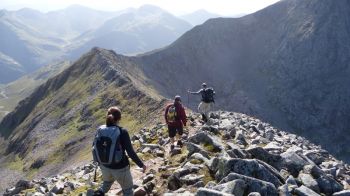
Scotland’s highest peak,Ben Nevis is a mere 1309m above sea level, but the route starts from sea level and ascends all the way to the summit. A climb/hike of 1000m ascent is a good long day out in most people’s estimation and should not be attempted unless you are fully prepared for a mountain day with over the ankle walking boots, extra layers of clothing, waterproofs, food, water, map and compass.
Mountain days in Scotland can involve long routes taking 8 or more hours to accomplish. The Cairngorm 4000ers trip which is run by Scot Mountain Holidays involves one day out whereby the bottom of the mountain is accessed by mountain bike to give at least a small chance of returning to base before dinner. Therefore to make the most of your time during you challenge, you’ll need to prepare beforehand by stepping up your fitness regime to build your stamina. Most challenges will last for more than one day, hence your fitness regime will need to take place more than one day of the week.
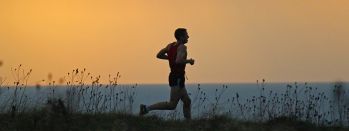
Travelling up to Scotland is not always a cheap option. To get train budget train tickets you either need to know you’re planning to travel 12 weeks in advance; be in the right place at the right time to see a special offer or win a competition; or have a railcard. Booking rail tickets close to your time of travel can add significantly to the cost of your trip.
Flights to Scotland are available from budget airlines like Easyjet and Ryanair, but again the price can vary considerably as there is less choice for flights directly intoInverness- though you could always try linking with flights into Edinburgh.
A guide will know the local terrain like the back of his or her hand. They’ll be able to keep the pace on track, regulate breaks etc so that the day does not extend too late into the evening, it’s their responsibility to manage the group and they’ll have all the necessary emergency equipment and contacts.
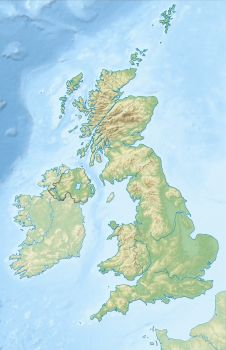
The best sites to monitor are:
The Mountain Weather Information service: the best resource for mountain weather information
The Met Office: go to the specialist forecasts section and check the mountain forecast.
If you also monitor the web cams in the week leading up to your trip it’ll give you an idea of what to expect on the ground.
For the Cairngorms the web cams are:
The weather in the UK, and particularly in the Highlands, is maritime and not continental i.e. it is constantly changing. When people say we can have 4 seasons in one day, they’re not joking – particularly in the spring one minute it can rain, the next snow, the next glorious sunshine … just don’t expect weeks of glorious sunshine; if we did, then Scotland would not be so beautifully green and lush. Always a good idea to have a warm hat and gloves at the bottom of your bag.
You can top up your water bottle from the streams on most of the hills in the Highlands as the water is potable. Dehydration is one of the most insidious hazards dangers in the hills.
In Scotland there are no alpine style mountain huts where you can stop and pick up provisions. There used to be a lot more emergency huts but they have never had wardens or been stocked with provisions. Hiking in the hills here in the UK means that you need to be self-sufficient and be prepared for any emergency. This is a philosophy we Brits take abroad when we hike so you can always spot us in the Alps. We’re the ones with the huge rucksacks with all our emergency supplies as opposed to many of the European hikers with their tiny packs relying on the huts for supplies.
May and September are when we have the longest days and most reliable weather in the Highlands of Scotland. Mid summer has it’s own hazards even if summer thunder storms are less common than in the Alps. We have midges and ticks to contend with in the summer particularly if the weather is still and you are on the west coast (Glen Coe and Skye are hot spots.)
You’ll be able to fit your route on to one side of the map and not have to readjust the map part way in to your route.
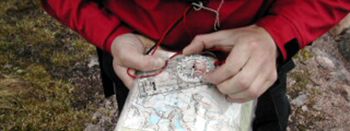
The tried and tested manual navigation aids which will always help you out
Not only do we climb Ben Nevis on this challenge but we do it by the most spectacular and challenging route including the Carn Mor Dearg Arete with stunning views of the cliffs which make up Ben Nevis’ north face. We also ascend Cairngorm via the overlooked north ridge and visit the popular winter climbing venue of Craig Meagaidh also known for it’s long cliff-face. The final route is on Ben a’Ghlo.
All routes are strenuous on their own so fitness is a priority for this trip
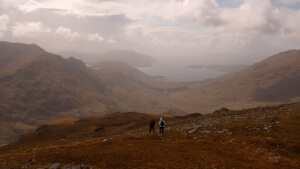 Tramping through the Scottish Highlands is the ultimate way to refresh yourself for the working week ahead.
Tramping through the Scottish Highlands is the ultimate way to refresh yourself for the working week ahead.Climb across Scotland’s rooftop, the highest, most extensive area of mountain plateau with an average annual temperature of zero degrees. This is a challenge you can build into as the longest day is generally the last day of the trip but is bi-modal due to the length of the route. Only the fittest of people attempt this challenge. You must be capable on a mountain bike.
Ascend the classic mountains in the Torridon range. An area of the Highlands which is greatly under-rated, perhaps by it’s proximity to Skye, Torridon has really to be seen to be amazed. Glen Coe, with its dramatic history, and Skye, by reputation and movie fame, receive a far higher number of visitors, but the scenery in Torridon can certainly hold its own in this company
Please enquire for details. Current top destination is Knoydart. Perfect for a sleeper weekend – long weekend would be best to make the most of the opportunity. Hot shower facilities also supplied.
When you have a very limited amount of holiday time, it’s very difficult to make choices for your time in Scotland without spending a lot of time in a car/bus/train as you’ll no doubt want to do everything the guide book recommends. Every different district in Scotland is busy promoting itself as “THE must-see destination”. No doubt you’ll want to spend some time in Edinburgh. A lot of people put Skye very high up the list. If you’re American, St. Andrew’s will no doubt be up there near the top of the list too and if you’re a first time visitor Loch Ness will probably be somewhere near the top too. How on earth are you going to fit it all in to your schedule?
Your first option of course is to consider one of the many minibus tours of Scotland, which will promise to take you to all the top sites and also deliver “off-the-beaten” track extras. They’ll reserve accommodation for you and suggest places to eat, but watch out. The quoted price is usually just for the bus tour and doesn’t include accommodation, meals or entry fees into the various places of interest. When you’re budgeting for one of these tours, make sure you take into account the extra expenses you will have to incur.
Many of these tours, particularly Rabbies, will also promise you some opportunities to get out of the bus and walk a wee bit. Most of these walks are very short (around 2 hours) and are generally in very scenic but popular places like Loch an Eilean (in the Cairngorms) or the Fairy Pools (on Skye).
Do you truly want to be part of a crowd? Another option is to hire a car and research an efficient route around the places you want to see. Try not to double back on yourself. See if you can find a suitable circular route. Visit Scotland have developed quite a few suggested itineraries on their site which are free to download and usually follow various themes so you should be able to find one which fits in with your interests.
We can offer self-drive itineraries. Please bear in mind that we are always going to recommend that you spend some time with us here in the Cairngorms National Park. We believe it is by far and away the best area to base yourself when exploring the Highlands.
Self-drive tours are a great way to go as you can be completely independent. You are able to get to all those out of the way places which are inaccessible on public transport. The disadvantage is that they can be very time-consuming to plan and if you don’t know the country you could make mistakes which cost you time-wise. Don’t forget to allow a relatively significant budget for fuel on top of the hire and activities you’ve planned.
A tailor-made itinerary with Scot Mountain Holidays doesn’t have to be too expensive. Don’t forget if you’re making comparisons that we provide a complete service. You won’t have to allow extra in your budget for additional meals or accommodation or activities. We’ll look after everything for you. Usually our prices include everything except alcohol from when we pick you up to when we drop you off. We can make adaptations to suit you and your party but our trips aim to provide you with a unique experience of Scotland not a package off the shelf.
Sometimes we do take our guests to the more popular tourist sights, like Loch Ness. If we didn’t include places like this, we wouldn’t get any enquiries. Usually however, these visits are not the most memorable parts of the visit. Sometimes guests are marginally disappointed by their day out with the rest of the tourists. One couple we worked with spent a week with us: they went hiking with Andy; they went out on mountain bikes exploring the forest and picking mushrooms; they went on the Zip wire in Aviemore and they went to Loch Ness (as on their itinerary). Their visit to Loch Ness was nowhere near as high on their list of memories as their day out with Andy in whisky country where they didn’t see another tourist all day.
Our hiking adventures are also aimed at providing all our guests with unique experiences so we avoid the hotspots other companies list as “off-the-beaten track” or as the French say “hors de sentiers battus” as in our opinion Glen Coe and the Old Man of Storr on Skye are not off the beaten track at all. We’d take you to places you’ve probably not heard of as below.
Hiking will be the focus of the trip and not visiting the popular tourist sights. You’ll certainly go home with a unique experience which will have involved all your senses: taste, touch, smell, hearing and sight. Memories created involving all your senses last longer and create more stories to share with your friends. No queues and no crowds!
Hikers descending from a long day’s hike in the Assynt area (Scotland)
There are lots of ways to explore Scotland from minibus or coach tours to hiking adventures. The method you choose will depend on your own personal priorities and who’s to say that you can’t come back and try another kind of experience the next time. We’ve certainly had some guests whose first experience of Scotland was a minibus tour round the highlights, but they’ve chosen to return and explore in greater depth with us as the bus tour merely whetted their appetite to see more.
Walking route options and choices
Planning a hiking holiday in Scotland (but not the West Highland Way)
Where to walk in the Highlands
The Lairig Ghru is the most prominent pass through the centre of the Cairngorms National Park. A road has never been built through the middle of it. It used to be a drovers’ pass for taking the cattle to market, but is now a route for walkers and cyclists to pass through the centre of the Cairngorms National Park. It runs roughly north-south from Aviemore to Braemar and is a prominent feature on the mountain skyline from Aviemore.
Hiking into the heart of the Cairngorms
Photo credit: David Mansell
The main roads all circumnavigate the Cairngorms National Park which means that to drive from one side near Braemar, to the other, near Aviemore, will take close to 2 hours. To access either end of the route you’ll need to make a massive diversion on public transport via either Perth or Aberdeen, as there is no longer a bus service from Grantown on Spey to Braemar. (The Council sponsored a bus route from Grantown to Braemar – the Heather Hopper, but when funding ran out no one took the route on.)
The route for hikers through the pass is 19 miles from Linn of Dee to Whitewell. However, if you plan to organise your own walk you’ll need to arrange for someone else to make the 2 hour diversion to the other end to meet you and take you back to your start point, or allow for the extra walk from Linn of Dee to Braemar, an additional 18 miles and perhaps the additional mile to Coylumbridge (and possibly from there to Aviemore if you miss the bus.
Traversing the Cairngorms on the classic Lairig Ghru route, which used to be a drovers road
Photo Credit: Scot Mountain Holidays
The hike is 19 miles (minimum) and passes through the main Cairngorm massif under Ben Macdui, Braeriach and Carn Toul. The high point is at approximately 2000ft, so not a mean feat. The high point is within sight of Aviemore and towards the end of the south – north route we advise. You’ll finish the hike within sight of the Lairig Ghru itself.
Scot Mountain Holidays have put together a package for hikers to make the Lairig Ghru accessible to small groups. We can accommodate up to 8 people in our own transport, but have also arranged the trip for larger groups with additional transport. Max: 14
We offer:
The trip is very popular with couples, but priced on our website for 4 or more people. Please enquire directly with us if your group is smaller than 4 people. We’ll quote you directly.
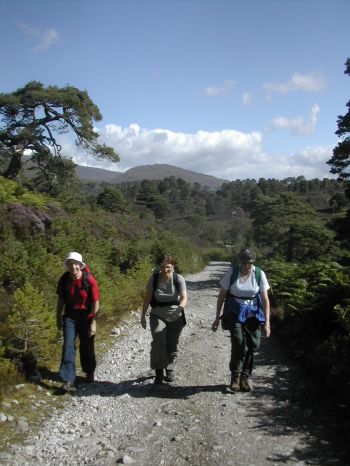
Photo credit: Scot Mountain Holidays
Hiking the Lairig Ghru is a challenge in itself which anyone can complete as a charity challenge. It is a well-known and clearly defined goal familiar to most Scottish hikers, though has less of a reputation south of the border. Some mountain rescue teams already offer the route as an organised challenge event. Please contact us if you are proposing to hike the Lairig Ghru to raise funds for a charity.
We can also offer the Lairig Ghru as a guided option which might be a good option if you are on your own as we are not able to combine self-guided groups for insurance reasons. Please phone: 01479 831 331 for full details or visit our contact us page.
All content © Copyright Scot Mountain Holidays 2025
Responsive web design by Summit Web Solutions